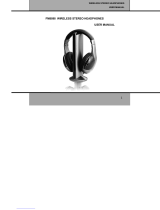8
English
9
BATTERY INSTALLATION AND INFORMATION (continued)
The LED indicator on the cradle/transmitter will be on whenever
the headphones are properly plugged in to charge. Note that the
light does not go out when the batteries are fully charged. The
charge current to the headphone is very low and there is no danger
in leaving them connected for extended periods of time.
5. Charge the rechargeable batteries for 16 hours before using the
headphones for the fi rst time. After the initial charge, an overnight
charge of 6-8 hours should be enough to return the batteries to a full
charge after use.
6. New batteries should normally last approximately eight hours
before recharging is necessary. Over time, battery replacement may
be necessary for maximum life.
NiMH Rechargeable Battery Memory Effect
When an NiMH rechargeable battery is fi rst used, it is important to fully
charge it and then allow it to discharge three times in order to maximize
the battery’s storage capacity. Avoid recharging the battery until it is
fully discharged. When a battery is recharged before it is completely
discharged, it develops a memory that will limit the amount of charge
in the future. This reduces the battery’s storage capacity for subsequent
charges and so reduces the amount of time your headphones can be
used before recharging is necessary.
NiMH Natural Power Discharge
Due to their chemical design, all rechargeable batteries incur some
degree of natural discharge. This means they automatically lose their
charge in varying degrees, and the battery’s capacity drops even
when not in use. The size of this power loss varies, depending on the
battery’s type, size, design, internal resistance and, most especially, the
temperature. The higher the temperature, the greater the power loss
through natural discharge.
NiMH Battery Warning
If you are using NiMH or NiCd batteries, the batteries will charge when
the headphones are powered with the AC power adapter. Do not power
the headphones with the AC power adapter if you installed alkaline or
other nonrechargeable batteries—this could cause the batteries to leak.
Do not mix batteries with different chemistry types (for example, a zinc
battery with an alkaline battery). Do not mix new and used batteries.
Do not leave batteries installed in the product when not in use for long
periods. Respect the environment and the law. Before disposing of
rechargeable batteries, ask your distributor if they can be recycled and
whether or not the distributor collects rechargeable batteries for recycling.
Follow this quick setup guide to ensure trouble-free installation of your
headphones. To connect the cradle/transmitter to the audio source,
follow these steps.
1. Connect the AC/DC main
power adapter to the DC IN
power supply socket (11) at the
back of the cradle/transmitter.
Then, connect the adaptor to an
electrical outlet. Important: This
power unit is intended
to be correctly oriented in a vertical or fl oor mount position.
2. Insert the audio input cable (13), located on the back of the cradle/
transmitter into the headphone jack of your audio source (e.g.,
stereo, TV, CD player, DVD, etc.).
Plugging the transmitter into the headphone outlet of a TV may
cause the TV speakers to mute. This is normal. The TV simply
thinks the user would like private listening and turns the speakers
off. If you would like to listen to the WHP141 headphones and have
the TV speakers on, you must use the stereo audio outputs of the TV,
usually located on the back or side panels. To use any RCA stereo
(red/white RCA jack) output from any device such as TV, cable box
or AV receiver will require the purchase of a 3.5mm female to RCA
stereo Y adapter (not included with the WHP141 model). To use the
adapter, simply plug the 3.5 mm jack from the transmitter into the
adapter jack, and plug the RCA ends into the audio output of your
source. Some TV models may require that you switch the audio
outputs to on, usually through the menu system. Please consult
your TV owner’s manual for specifi c instructions. Note that this
headphone model is compatible with analog stereo outputs only.
It is not compatible with digital outputs such as optical or coaxial
SPDIF.
3. The audio signal LED indicator light (9), located on the front of the
cradle/transmitter, illuminates as soon as you have connected the power
adapter to the outlet and the audio cable to an active signal source.
CONNECTING THE CRADLE/TRANSMITTER












